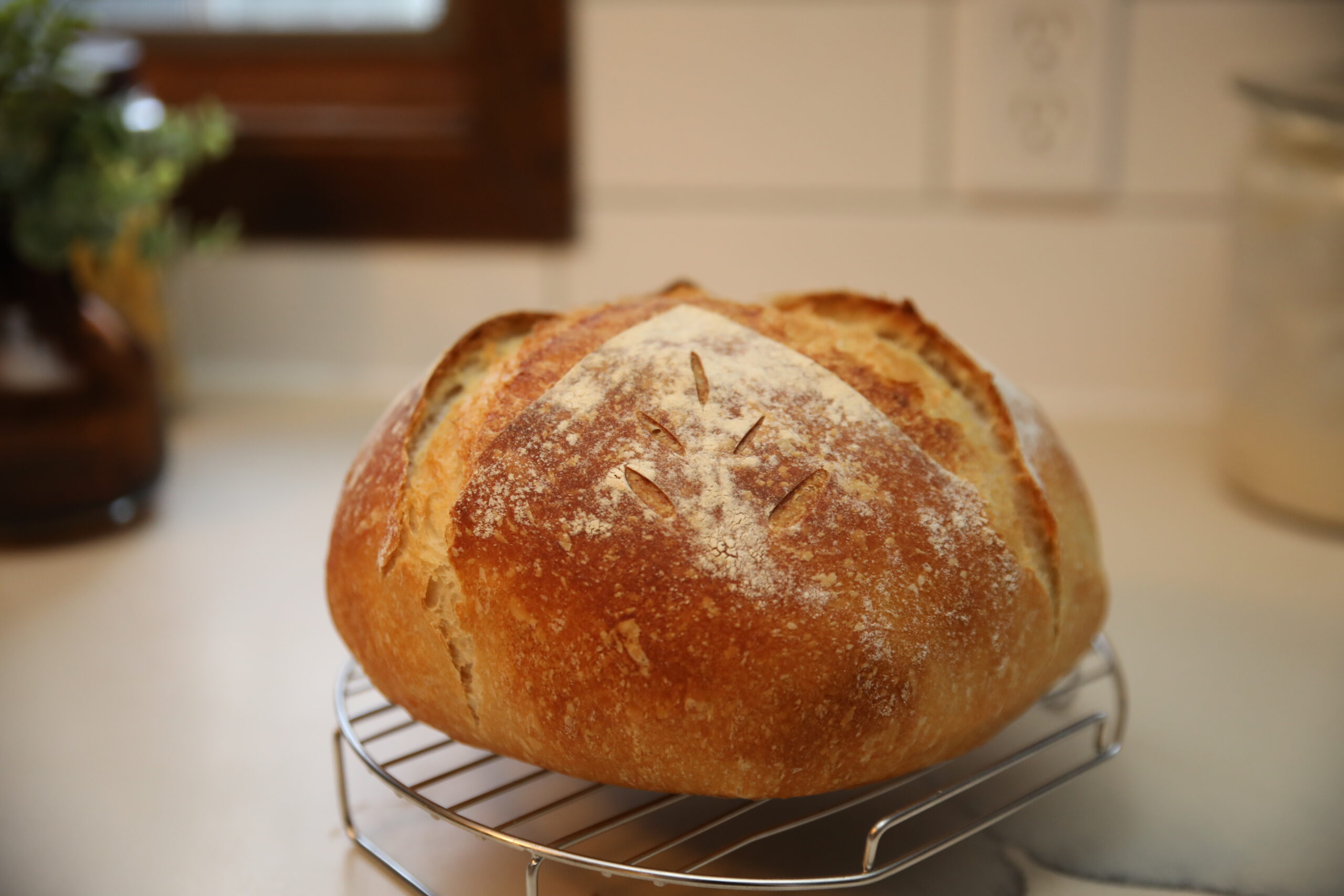Sourdough baking is a rewarding yet sometimes frustrating journey. If you’ve ever ended up with dense loaves, weak starters, or gummy interiors, you’re not alone! Here’s a troubleshooting guide to help you fix the most common sourdough mistakes and improve your bread baking skills.
note: all links are affiliate links to support me and are at no extra charge to you!
1. Weak or Inactive Starter
Problem: Your sourdough starter isn’t bubbling, rising, or developing a strong aroma.
Fix:
- Feed your starter with equal parts flour and water by weight.
- Use unbleached flour, as bleaching agents can weaken fermentation.
- Keep it in a warm place (75-80°F) to encourage yeast activity.
- Feed it regularly, at least once daily, or twice if very weak.
- If neglected, refresh it with multiple feedings over a few days.
2. Dense or Heavy Bread
Problem: Your sourdough loaf comes out too dense and lacks an open crumb.
Fix:
- Ensure your starter is active before baking (it should double within 4-6 hours of feeding).
- Allow enough bulk fermentation time; under-fermentation leads to a dense loaf.
- Use proper folding techniques to build strength in the dough.
- Consider increasing hydration if the dough is too stiff.
- Make sure you’re shaping the dough tightly to create good structure.
3. Gummy or Underbaked Bread
Problem: The interior of your bread is sticky, gummy, or seems wet even after baking.
Fix:
- Extend the baking time; an underbaked loaf will be gummy inside.
- Ensure the oven temperature is accurate using an oven thermometer.
- Let the loaf cool completely before slicing. Sourdough continues to set as it cools.
- Make sure the dough is fully proofed before baking.
4. Overproofed Dough
Problem: Your dough is too slack, spreads out instead of rising, or collapses in the oven.
Fix:
- Reduce proofing time, especially in warm conditions.
- Use the “poke test”: gently press a floured finger into the dough. If the indentation stays, it’s overproofed.
- If slightly overproofed, try refrigerating it for an hour before baking to firm up the dough.
- Next time, watch for dough doubling in size rather than relying on time alone.
5. Lack of Oven Spring
Problem: Your loaf doesn’t rise well in the oven and stays flat.
Fix:
- Ensure proper gluten development through sufficient kneading or stretch-and-folds.
- Use steam in the oven (by adding a pan of hot water or baking in a Dutch oven) to allow for better rise.
- Score the dough with a sharp blade to guide expansion.
- Bake at a high initial temperature (450°F) for the first 15 minutes to encourage oven spring.
6. Too Sour or Not Sour Enough
Problem: Your bread is either too tangy or lacks the sour flavor you expect.
Fix:
- For more sour bread, use a stiff starter, cold-proof for longer (12-24 hours), and extend bulk fermentation.
- For less sour bread, feed the starter more frequently, use a shorter proofing time, and avoid extended refrigeration.
7. Hard or Thick Crust
Problem: Your crust is too thick or hard to chew.
Fix:
- Add steam during baking to keep the crust from setting too fast.
- Bake at a slightly lower temperature if your oven runs hot.
- Brush the crust with butter after baking for a softer texture.
- If storing, wrap in a towel instead of plastic to prevent excessive hardening.
8. Sticky Dough That’s Hard to Handle
Problem: The dough is too wet and difficult to shape.
Fix:
- Use a light dusting of flour or wet hands when handling.
- Allow the dough to rest between stretch-and-folds to develop strength.
- Refrigerate for 30 minutes before shaping to make handling easier.
- Reduce hydration slightly if struggling with very wet dough.
9. Burnt Bottom Crust
Problem: The bottom of your bread is too dark or burnt.
Fix:
- Place a baking sheet or pizza stone on a lower rack to diffuse direct heat.
- Use parchment paper or bake on a different surface.
- If baking in a Dutch oven, elevate the loaf with a piece of parchment or a trivet.
10. Inconsistent Results
Problem: Sometimes your sourdough turns out great, and other times it flops.
Fix:
- Keep a baking journal to track variables like temperature, hydration, proofing time, and flour type.
- Use the same flour brands and water source for consistency.
- Adjust based on seasonal changes—dough ferments faster in warm weather.
- Be patient; experience improves consistency over time!
Final Thoughts
Sourdough baking takes practice, but every “failed” loaf is a learning experience. By troubleshooting these common mistakes, you’ll refine your technique and get closer to achieving bakery-quality sourdough at home. Keep experimenting, stay patient, and enjoy the process!
Have a sourdough issue not covered here? Drop a comment below, and I’d love to help!

